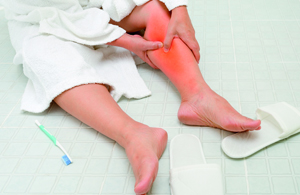Falls make an impact
8/26/2021 by Paul Takahashi, M.D.

Midwesterners are pros at the "wintertime shuffle" — walking like a penguin with arms out to the side, taking small shuffling steps with toes pointed out. It's a hard-learned survival "dance" for preventing those slip-slide falls on ice and snow.
But falls can happen at anytime in any season at any age.
Falls happen in the blink of an eye. One minute you're vertical, and the next you're on the ground or floor, hopefully still in one piece. Injuries are the third cause of death in the U.S., and many of those injuries are due to falls.
Those most at risk for falls are kids, older adults and those who have fallen before. The consequences of falls range from minor bumps and bruises to major injuries that could lead to losing your independence or even death.
Unfortunately, no pill, shot or easy fix can prevent falls. You can slip-proof your home by:
- Getting rid of clutter, particularly on floors.
- Packing away throw rugs.
- Making sure you've got good, effective lighting.
- Ensuring steps and floors are in good repair.
- Having an occupational therapist perform a home evaluation to see what hazards could trip you up.
You also can slip-proof your body. It's all a matter of strength and balance.
Activity builds strength, even simple activities like getting up out of a chair. Balance is one of those underrated skills when considering overall fitness. It's even something you can work on at home with little or no equipment.
Here are some ideas for building up your balance muscles:
- Chair exercise
This strengthens your "sitters and standers" — quadriceps and hamstrings. Choose a stable chair with good arms. Sit and then stand 10 times. Repeat this exercise twice per day. As you get stronger, use your arms less. You can find printable instructions here. - Standing balance
Stand next to your kitchen table or counter. Stabilize yourself for support. Start with your feet together. Gradually work up to putting one foot more forward, then putting one foot in front of the other — like your standing on a beam. As you progress, use the table less for support. - More standing balance
You can do this one every day while you're brushing your teeth. Stand on one foot for one minute. Then stand on the other foot. - Yoga or tai chi
If you're interested, sign up for a yoga or tai chi class at a gym, community center or through community education.
You can learn more about preventing falls on the Centers for Disease Control and Prevention's Stopping Elderly Accidents, Deaths & Injuries Program website. Also, talk with your primary care provider to learn if any of your medications could affect your balance or if you could benefit from physical therapy to improve your strength, balance or the way you walk.
Paul Takahashi, M.D., is an internal medicine physician in the Division of Community Internal Medicine. He practices in the Baldwin Building in Rochester. His interests include geriatric medicine, long-term and nursing home care, and public health.
